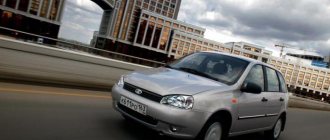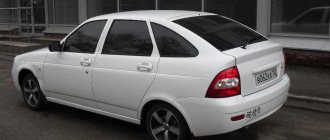In parallel with the development of the “Ten”, a more practical version of it was created in Togliatti - in a station wagon body. Moreover, the concern already knew in advance who the main consumer of such a car would be - a person who values practicality or needs it. Years later, the stable demand for the “eleventh” became confirmation of the successful calculation of VAZ, and the station wagon itself took a strong position in the segment of utilitarian cars in the budget segment.
The history of the creation of the VAZ 2111 begins in 1987. The Soviet (at that time) station wagon was supposed to become an integral and important part of the tenth Lada family, as well as attract a new consumer audience - people who needed high utilitarian capabilities of the car.
However, the creation of a new project fell on an unstable time - the era of “perestroika”, which entailed a reorientation of the economic system of the USSR on the “new rails” of a market economy. This resulted in the cessation of funding for many enterprises, including VAZ. In this regard, the new Lada entered the assembly line only in 1998.
However, it is worth noting that during the long years of stagnation, domestic engineers did not waste time - the enterprise was actively working on the design of the body of the future station wagon, creating numerous projects and mock-ups. The creators lengthened the rear of the Lada 2111, making it less swift.
Appearance
The design of the car was borrowed from the “ten”. Essentially, this is the same VAZ-2110, only with a larger trunk and roof rails. The car has an identical shape of the front end, fenders and doors.
Many spare parts for the station wagon are suitable from “tens”. This is a big plus, which is noted by owner reviews. The VAZ-2111, depending on the configuration, was equipped with stamped or cast wheels of 14 diameter. Basic versions could also be distinguished by the plugs on the foglights. Otherwise there are no differences. Like the “ten”, branded mirrors with a bluish anti-reflective coating were used here. But motorists have different opinions about the VAZ-2111. Many people criticize these mirrors because they are uninformative and install regular ones from disassembly. In practice, some objects actually disappear in them. But this anti-reflective coating only works at night, and even then only slightly.
Production of VAZ cars
Volzhsky Automobile), the largest Russian and Eastern European manufacturer of passenger cars, established in 1966. Initially, it was a joint Soviet-Italian project, so the first car, released in 1971 under the designation VAZ-2101, was designed on the basis of the Italian Fiat-124 model. Subsequent cars were also essentially modified versions of the Italian small car.
The first independent project of the plant is considered to be a series of front-wheel drive vehicles of the Sputnik family (base model VAZ-2109). The subsequent development was a series of passenger cars called “Ten”.
VAZ-2111 - photo and interior review
The wagon's interior is no different from the 2110 sedan. It has the same solid, angular dashboard with a thin, two-spoke steering wheel. The center console is slightly turned towards the driver. It contains two deflectors, a heater control unit (in expensive versions the car is equipped with air conditioning), as well as a door opening indicator. Below there is a niche for all kinds of little things. The glove compartment on the passenger side is very flat and does not lock.
The main complaints from owners concern the build quality of the interior. The plastic is very hard and begins to disintegrate over time. This is especially true for the center console. After 3-4 years of operation, it begins to crunch and play. This problem is difficult to solve even with additional sound insulation. The steering wheel has an uncomfortable grip, as noted by reviews from VAZ-2111 owners. There is no analogue to it, and the only one available on the market is the Chinese “ProSport”, which is even worse in quality than the factory one.
The seats are very hard - this is evidenced by reviews from VAZ-2111 owners. And although the station wagon is designed for five people, only four can fit normally. There is very little free space in the back. The problem of lack of luggage compartment volume in a station wagon has been solved. Unlike the sedan, which has a capacity of 450 liters, the station wagon can hold up to 775.
Front-wheel drive station wagon
The first car of the VAZ-2111 model rolled off the assembly line of the Volzhsky Automobile Plant in 1998. He was a representative of the new front-wheel drive tenth model family, designed to replace outdated classic cars in the company's production line. It should be noted that the VAZ-2111 became the first serial domestic station wagon with front-wheel drive.
Another distinctive feature of the tenth family is the fact that the company’s designers developed several modifications at once, and therefore the technical characteristics of the VAZ-2111 are very similar to those of its classmates in the following version:
- sedan - 2110 (produced from 1997 to 2010);
- five-door hatchback – 2112 (1998-2011);
- three-door hatchback - 2123 (2002-2009).
The station wagon was produced at the Volzhsky Automobile Plant until the spring of 2011. Under the designation “Bogdan” the car was manufactured at the Cherkasy Automobile Plant (Ukraine) until 2014.
Specifications
Various power plants were installed on this car. The weakest in the line is a one and a half liter engine with an 8-valve timing mechanism producing 72 horsepower. It was installed on early versions of the station wagon and featured a carburetor power system.
Next came injection engines with distributed injection. This is a “tenth” unit with a capacity of 1.5 liters and a capacity of 77 horsepower. There are also larger engines in the lineup. Thus, the car was equipped with a 1.6-liter engine with 82 horsepower, which then increased to 89. This was facilitated by the installation of a 16-valve head instead of an 8-valve one. The most powerful in the line is a 93-horsepower gasoline engine with two camshafts. He came to the station wagon from the 12-series hatchback. As for the transmission, all power units were equipped with a non-alternative 5-speed manual transmission.
The acceleration dynamics are almost the same as those of the “ten”. Acceleration to hundreds takes from 12.5 to 14 seconds, depending on the engine. But the car is very sensitive to overloads. This is significantly reflected in its dynamic characteristics.
Fuel consumption for all units is approximately the same. So, in city mode the car spends 9 liters per hundred. On the highway this figure drops to 8-7. For those who want to save even more, it is possible to install gas equipment. The design of the engine of the 11th Lada is quite conducive to this, without global “reflashing”.
Modifications
| Name | Year of issue | |
| LADA 111 (2111) 1.5 | 01.1996 — 12.2005 | Characteristics |
| LADA 111 (2111) 1.5 16V | 01.1995 — 08.2002 | Characteristics |
| LADA 111 (2111) 1.5 | 10.2000 — 12.2005 | Characteristics |
| LADA 111 (2111) 1.5 16V | 10.2000 — 12.2005 | Characteristics |
| LADA 111 (2111) 1.6 | 09.2004 — 12.2013 | Characteristics |
| LADA 111 (2111) 1.6 | 09.2004 — | Characteristics |
Underwater rocks
Let's look at what owners' reviews say about the VAZ-2111 car. The advantages of this car mainly concern the trunk. As for problems during operation, they begin after 50 thousand kilometers. First of all, the cooling system makes itself felt. Over time, the pipes leak. The expansion tank cap stops working and does not relieve pressure in the system. As a result, the tank simply bursts.
The clutch disc has a resource of 120 thousand kilometers. But the release bearing wears out by 75. If you repair the clutch assembly, then completely change all the elements. These are the disc, basket and releaser. At 175 thousand, the seals on the gearbox break. The transmission itself, unlike the “nines”, does not require rocker adjustment and does not rattle over time. At 200 thousand, the anthers of the outer CV joint burst. They need to be changed together with the clamps (be sure to use a specialized lubricant for the hinges).
Creation of the “tenth” family
AvtoVAZ began preparing a new generation of front-wheel drive cars (base model VAZ-2110) in the mid-eighties. The main objective of producing cars in this series was to replace the company's classic model range. In order to speed up design work, the entire model range of the family was simultaneously constructed, which consisted of the following representatives:
- sedan;
- station wagon;
- hatchback (five-door);
- hatchback (three-door).
Despite this organization of work, the period of crisis did not allow the emergence of new models to be accelerated, and mass production began in 1996. Initially it was the VAZ-2110 sedan, then the production of a station wagon under the symbol 2111 (VAZ-11) and a five-door hatchback 2112 (VAZ-12) began. For foreign buyers, cars received the following designation options:
- LADA-110;
- LADA-111;
- LADA-112.
The cars immediately gained popularity among buyers, primarily due to their affordable cost, individual appearance and comfort previously unavailable for domestic small cars. Production of the sedan continued until 2010; production of VAZ-11 and 12 cars ceased in 2011. It should be noted that the three-door hatchback VAZ-2123 was manufactured from 2002 to 2009.
Exhaust
The VAZ-2111 is equipped with a catalytic converter, which becomes clogged at 100 thousand. Naturally, no one is replacing it. The catalyst is cut out and a blende is installed. On engines with an ECU, additional firmware is done so that fuel consumption does not increase.
The muffler begins to rust after 2-3 years of operation. It is aluminized, but this coating quickly peels off the metal. The exhaust manifold and “pants” take a very long time to take care of.
Gearbox and suspension
A five-speed manual transmission is used to change gears in this car. Compared to the Samara gearbox, this transmission is “a cut above.” A test drive of the VAZ 2111 showed that in terms of noise level and smooth shifting, the new transmission beats the VAZ 2108, 2109 and 21099.
The design of the Lada 111 gearbox assumes the presence of a primary and secondary shaft, on which the drive and driven gears are located, and a differential. All forward gears are equipped with synchronizers. Five gear ratios: 3.636, 1.95, 1.357, 0.941, 0.784; reverse gear - 3.5. The final drive ratio is 3.7. Factory transmission oil - TM-5-9p. It is recommended to replace it after 75,000 km.
An independent suspension is used at the front. Shock-absorbing struts are hydraulic and also telescopic. The front end also includes coil springs and lower wishbones. The stabilizer provides lateral stability. To improve handling and stability, both front wheels are located at an angle to the racks and body.
The “rear” of the Lada 111 is damped by the forces of the dependent suspension. It consists of a transverse beam, coil springs and hydraulic telescopic shock absorbers. The beam consists of trailing arms and a connector; these elements are welded together.
The front brakes of the Lada are ventilated discs, and the rear ones have a drum mechanism. The parking brake and clutch are driven by cable.
About corrosion
The body is very afraid of rust. It appears within 3-4 years. Reviews from VAZ-2111 owners note that if it is not removed in time with the converter, corrosion will quickly spread throughout the entire body. To extend its life, anti-corrosion treatment should be done regularly.
Problem areas of the body are the sills and rear arches. In order to protect the latter, many install fender liners. But it is strictly forbidden to mount them on self-tapping screws - this will further accelerate the corrosion process. If you regularly treat the arches with Movil and anti-gravel, you can do without fender liners altogether.
Reviews about the car
Among the main advantages, in addition to the versatility and technical characteristics of the VAZ-2111, car owners note:
- interesting design;
- high-quality head optics;
- a significant number of power units;
- affordable price;
- comfortable interior;
- permeability;
- overall reliability.
The main disadvantages are:
- low quality paintwork;
- poor sound insulation;
- assembly defects.
Thanks to the station wagon body, affordable price and high-quality technical characteristics, the VAZ-2111 has become the longest-running modification of the tenth family of Volga small cars.
Application and general characteristics of the engine
Unit 2111 could be installed on the entire line of Lada Samara models, starting from 2108 to 2115, as well as on the “ten” and its modifications (2110-2112).
The working cycle of the VAZ 2111 engine (injector) is classic, that is, it is carried out in four strokes. Fuel is supplied to the combustion chamber through nozzles. The cylinders are arranged in one row. The camshaft is mounted on top. The internal combustion engine is cooled by force using a closed liquid system, and the parts are lubricated by a combined lubrication system.
Pistons and connecting rods
The dimensions of the 2111 engine pistons (injector) are similar to those installed on the 21083 and also have a shockproof recess on the bottom, ensuring the safety of the valves if the timing belt breaks.
The difference lies in special grooves for the circlips, which prevent the piston pin from moving. The finger itself differs from that used on model 2108. If the outer diameter remained the same, that is, 22 mm, then the inner diameter was reduced to 13.5 mm (it was 15). In addition, it was shortened slightly - by 0.5 mm (60.5 mm).
The size of the piston rings was not modified - 82 mm, but the connecting rod was redesigned: its lower head became more massive, the profile changed, and a more durable alloy resistant to mechanical stress was used for its manufacture.
The length of the connecting rod is 121 cm.
Features of the 2111 engine cylinder block (injector, 8 valves)
First of all, you can distinguish the model 2111 cylinder block from the 21083 block by the additional holes used to attach the generator bracket, as well as the ignition module and knock sensor.
The bolt holes for mounting the block head have a thread size of M12 x 1.25. The height of the block, if we take the distance from the crankshaft axis to the platform on which the cylinder head is installed as this value, is 194.8 cm. The original cylinder diameter is 82 mm, but repair boring can be carried out by 0.4 mm or 0.8 mm. The maximum wear of the “mirror” (surface) of the cylinder should not be more than 0.15 mm.
The 2111 engine has a crankshaft mod. 2112-1005015. It is identical in seating to the 2108 shaft, but its counterweights are larger and have undergone additional factory processing to significantly reduce rotational vibration and improve overall reliability.
VAZ 21111 2004 Station wagon: characteristics, reviews, tests
Detailed characteristics of the VAZ 21111 in numbers, among the most important ones that people most often pay attention to are the price in rubles at the time of appearance in car dealerships and fuel consumption in various conditions: city highway or mixed, as well as the total and curb weight. Also important are the dimensions and volume of the trunk, ground clearance, maximum speed, acceleration to 100 km in seconds or the time spent covering 402 meters. Gearbox automatic, manual; rear-wheel drive, front or all-wheel drive, or maybe even switchable
Main indicators of VAZ 21111 2004 Station wagon characteristics of VAZ 21111
With such an engine capacity of 1596 cubic meters, a decent number of horses under the hood is ensured, although the consumption will not be very high.
A drive that requires special driving skills and getting used to in the case of driving with a different type of drive. For such a low price, cars are considered budget cars since you just get a car to drive and nothing more, but in some cases this is the only purpose without any beauty. You don't need more to get around the city. Perhaps the slogan for such a vehicle is not “The miser pays twice.”
There are other names or misspellings:
Price:
VAZ 21111 / VAZ 21111
21111: parameters, tests (test drive, crash test), reviews, car dealerships, photos, videos, news.
VAZ 21111 - launched in 2004. The combination of style and technology 21111, created by VAZ, has proven itself in the market and is time-tested. This station wagon is perfect for the head of a large family, lovers of outdoor activities or summer residents. The very name of the “station wagon” body speaks about how suitable this type is for everything. Among the existing basic colors of 21111 you can easily find one that suits you, but most likely you can choose it to order. We most likely do not have all the configurations of this VAZ 21111 model, among which are various assembly options for the 21111: the gearbox can be automatic or manual, the interior is trimmed with leather or wood inserts, wheels and other additional body elements of the 21111, which will certainly be reflected in the price 21111. Technical characteristics are good, but do not forget about the safety of 21111 or the engine size, which will then make itself felt in terms of operating costs in the future, as well as repairs of 21111 and maintenance with a warranty period. Since the purchase is made not for several months, but for several years, therefore, consider for yourself what you will do in the summer and winter, what trips to make on the 21111. The table below shows a comparison of several configurations of the 21111, among the parameters are reflected: what dimensions Dimensions of 21111, fuel consumption in the city, highway or mixed, engine size, maximum speed and acceleration time to 100 km/h, curb or gross weight of 21111, wheelbase, track of front and rear wheels, type of transmission (gearbox/gearbox) gears), what drive, what tire size, what horsepower or torque, and what price. In addition to all the numbers, you can read reviews of car owners about 21111, watch videos or news, tests (test drive, crash test).
Characteristics and review (test/test drive/crash test) VAZ 21111 2004. Prices, photos, tests, test drive, crash test, description, reviews VAZ 21111
VAZ 21111 The characteristics of the VAZ 21111 2004 provide information about the body (body type, number of doors, dimensions, wheelbase, curb weight, gross weight, ground clearance), speed indicators (maximum speed, acceleration to 100 km per hour), fuel indicators ( fuel consumption in city/highway/combined cycles, fuel tank volume or fuel type), what type of transmission - manual or automatic and how many gears 21111 has, the number of gears may be missing, type of suspension front and rear tire size. front and rear brakes (disc, ventilated disc...). Engine - engine type, number of cylinders, their location, engine displacement v, rated power / torque - all this is in the summary table. All indicators are indicated for individual configurations: VAZ 21111 2004.
In other tabs you may also be interested in the test, test drive/review, crash test, VAZ video, owner reviews of the VAZ 21111 (but it should be noted that the reviews are not left by experts and are subjective, although some reviews reflect problem areas), announcements and VAZ news . In the AUTO -> DEALERS section there is information about dealers, telephone numbers and descriptions of showrooms, addresses of VAZ dealers in Russia, Ukraine, Kazakhstan, the CIS, website addresses. A convenient search by brand will result in a list of cities. Perhaps you were looking for something and came to the page with a description of 21111 and did not immediately notice what you needed: look in the tabs (parameters, review (test drive), crash test, photos, videos, reviews, car dealerships where you can buy a VAZ, VAZ news, advertisements VAZ) Also, after reading the review (test drive/test), you can read the reviews of VAZ car owners.
VAZ 21111 2004 Station Wagon (VAZ 21111) 9 out of 10 based on ratings. user reviews.
www.230km.ru
Reviews from car owners about the model 2111 engine
As most car owners whose cars are equipped with the 2111 engine note, in general the unit is quite reliable: despite the fact that its working life, declared by the manufacturer, is 250 thousand km, in fact, subject to regular maintenance, the use of high-quality fuel and technical fluids its resource can be extended to 350 thousand km.
However, despite the transformations carried out, this engine inherited the disadvantages of previous models (21083 and 2110):
- requires periodic valve adjustment;
- rapid failure of individual elements of the cooling system, in particular the water pump;
- problem with oil leakage from the valve cover gasket;
- failure of the submersible fuel pump.
- breakage of the studs on the exhaust manifold at the place where the exhaust pipe is attached.
You can get rid of the last drawback by replacing the steel (factory) studs with brass ones.
And in conclusion: the 2111 engine, the price of which in Russia is about 60 thousand rubles, is a fairly popular model, and often the owners of VAZs, which also have carburetor engines, independently changed them to an injection engine.
Appearance
The design of the VAZ-2111, although inferior in its execution to similar foreign models, was quite interesting and memorable. The company’s designers managed to create this appearance through the use of the following solutions:
- the rapid slope of the hood and windshield;
- wide, almost rectangular head optics design;
- stepped massive front bumper;
- frontal stamping from the front wings to the rear of the car;
- top rails;
- high roof line;
- large side windows;
- slight tilt of the tailgate;
- interesting design of wheel rims;
- top spoiler with built-in additional brake light;
- powerful rear combination lights connected to each other by a plastic insert;
- extended tailgate.
All these decisions formed the image of a large, reliable, universal car for family trips, and also capable of transporting large cargo if necessary.
Location under the hood of the car
The 2111 engine, together with the gearbox and clutch mechanism, forms a single power unit, which is mounted on three rubber-metal supports in the engine compartment of the car.
To the right (if you look in the direction of movement of the car) from the cylinder block there is a set of drives: a crankshaft, a camshaft, and a pump for pumping antifreeze through the cooling system. The drives are made in the form of toothed pulleys connected by one belt. A generator is installed on the same side, which is also connected to the crankshaft pulley via a poly-V-belt.
A thermostat with a temperature sensor is mounted on the left side of the cylinder block.
The starter is located at the bottom of the front part. Between it and the generator there is an ignition module, from which high-voltage wires go to the spark plugs. There (to the right of the module) a dipstick is installed, immersed in the engine crankcase, for manual control of the oil level.
At the rear of the BC there is a receiver with a fuel rail and injectors, just below there is an oil filter, as well as intake and exhaust manifolds.











